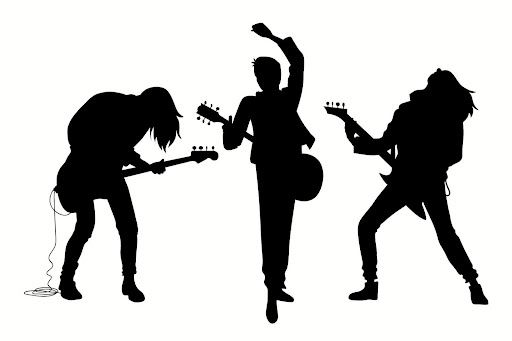Band tees are more than just pieces of fabric stitched together. They are living memories, emotional souvenirs, and personal declarations of identity. Whether you find one buried in a thrift store bin or spot someone wearing one in a crowd, band t-shirts hold a quiet power—connecting people to moments, music, and emotion.
Some people collect band tees the way others collect vinyl records or posters. For them, it’s not about fashion—it’s about memory. That faded black shirt from a 1986 tour, or the oversized tee that once belonged to your older sibling, carries a history that goes beyond the design.
But what is it that gives these shirts such cultural gravity?
Not Just Merch—But a Statement
A band tee is rarely just about the band. It’s often a mirror of the wearer’s emotional world. It says, “This is who I listen to,” but more deeply, “This is who I am,” or even, “This is who I was when I needed them most.”
Every band has its own tribe. The imagery, lyrics, and spirit they carry often find their way onto shirts, and those shirts become walking stories. They’re bookmarks in the lives of fans, tied to road trips, heartbreaks, live concerts, and personal revolutions.
Wearing a shirt with your favorite band’s name or logo is, in some ways, like speaking a secret language. It invites knowing nods from strangers, starts conversations, and occasionally sparks deep friendships. Music lovers instinctively understand the gravity of this shared code.
The Evolution of the Band Tee
Back in the 1960s and 70s, concert merchandise was relatively simple—often just plain white tees with black-and-white logos. As bands became more aware of the emotional power of branding, tees became canvases for creative expression. Psychedelic prints, album art, tour dates, and experimental fonts transformed the humble band tee into a piece of wearable art.
Over the decades, these shirts have evolved from simple tour souvenirs into a cultural phenomenon. Today, vintage band tees sell for hundreds—even thousands—of dollars. Not because they’re rare, but because of the stories they carry. The cracked ink, the fraying collar, and even the holes tell a narrative of nights danced away, mosh pits survived, and memories etched into time.
Music, Memory, and Fabric
What sets band tees apart from other kinds of clothing is their emotional texture. When you wear one, you’re not just putting on a design—you’re wearing the energy of a performance, the lyrics of a song that once helped you through something, or the echo of a crowd singing in unison.
It’s a deeply personal ritual. Sometimes it’s to honor a band that saved you. Other times, it’s a way of staying connected to someone you’ve lost. And in many cases, it’s a tribute to a younger version of yourself—the one who danced barefoot in their room, cried over heartbreak, or found strength in the words of a song.
Style Meets Sentiment
Ironically, in today’s fashion world, band tees are everywhere—even on people who’ve never heard the band they’re wearing. That’s not necessarily a bad thing. It shows how these shirts have crossed over from music memorabilia to mainstream aesthetic.
But for those who truly lived the music, a band tee is sacred. The way it fits, the way it has faded with time, and the memories sewn into every fiber give it value that can’t be replicated by a new shirt off the rack.
Wearing one isn’t just about looking cool—it’s about remembering who you were, who you are, and everything in between.
Queen: A Timeless Soundtrack
Take Queen, for example. Few bands have captured hearts across generations quite like they have. Their music spans genres, continents, and emotions. For many, their songs were the backdrop of defining life moments. Whether it’s blasting “Bohemian Rhapsody” with friends or finding comfort in “Somebody to Love” on a lonely night, Queen’s influence is deeply personal.
Wearing a band Queen t shirt isn’t just a nod to Freddie Mercury’s legendary voice or Brian May’s guitar riffs. It’s a reflection of your connection to the music that dared to be different—bold, theatrical, unapologetically emotional.
And while some people wear Queen tees for fashion, others wear them like armor. For them, it’s not about being trendy—it’s about carrying a piece of something that made them feel seen and heard.
What Makes a Shirt Worth Keeping?
So what separates a shirt that gets tossed after a season from one that stays folded in your drawer for years? It’s the meaning.
Band tees age like fine wine. The more you wear them, the more they become part of your personal timeline. They adapt with you through new music phases, life changes, and emotional growth. The ink may fade, but the feelings never do.
Some shirts represent that first concert with your best friend. Others remind you of a summer road trip, windows down, and music blasting. And a few might carry even deeper meaning, linking you to someone who’s no longer here.
These shirts are part of your story. They may not speak, but they hum with memory.
Passing It Down
In many ways, band tees become heirlooms. Passed from older siblings to younger ones, from parents to kids, or simply saved for nostalgic days.
There’s something beautiful about the idea of giving someone a shirt tied to music that shaped you. It’s a quiet way of saying, “This helped me. Maybe it’ll help you too.”
Even worn and torn, they hold weight. They aren’t disposable like fast fashion—they’re treasured, stitched with sentiment and songs.
Final Thoughts
There’s something deeply human about the way we hold on to music. And wearing that music—carrying it on your chest—is one of the most vulnerable and powerful ways to express yourself.
Band tees are less about fashion and more about feeling. They help us carry the voices we once needed, the memories we cherish, and the songs we’ll never forget.
So next time you pull out that old shirt, pause. Feel the fabric, remember the beat, and know that you’re wearing more than just a tee—you’re wearing a piece of your soul.











+ There are no comments
Add yours